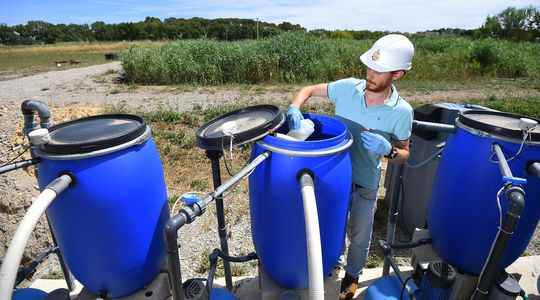Already affected by an unprecedented and particularly intense heat wave in June, France is now facing the double penalty of a drought that could set in for a long time this summer. More than forty departments are experiencing water restrictions this Saturday, and at June 18 nearly 130 arrested were taken to moderate the use of the resource. Earlier this week, the Bureau of Geological and Mining Research, which regularly monitors the state of underground water resources, warned of historically low groundwater levels in certain regions. “We have already experienced droughts in the groundwater so early, but it was localized. This year, it is generalized to almost all of France”, explained during a press briefing Violaine Bault, hydrogeologist at BRGM.
In the towns and cities affected by this phenomenon, the question of adaptation to these increasingly marked episodes of drought has arisen for several years. A solution now seems to be gaining ground: making better use of wastewater. The idea is not entirely new. This dirty water, once reprocessed, has been used for many years in countries particularly affected by water stress. But in France the technique is still struggling to develop, particularly because the availability of this resource has not always been a concern. “Today, unlike neighboring countries, we use less than 1% of treated wastewater while Italy is at 10%, and at the other end of the spectrum Israel even reuses 95%”, is surprised Tristan Mathieu, the general manager of the FP2E, the group of actors in the water sector.
Safe irrigation
Several solutions already exist in France to meet crop irrigation needs, watering public gardens and golf courses, or cleaning roads. In 2017, the center for studies and expertise on risks, the environment, mobility and planning had nearly 150. However, only 63 were in operation and new projects are still timid. “The agricultural use of the Reuse of treated wastewater (REUT) is struggling to diversify despite emblematic historical successes”, noted a report dating from 2020 giving an overview of the question. He cited in particular market garden irrigation in Noirmoutier, in place since 1981, but also on the Ile de Ré, since 1993.
Not far from Montpellier (Hérault), Nassim Ait Mouheb is carrying out an experiment on an agricultural plot and vegetable crops for the national institute for agronomic and environmental research (Inrae) aimed at improving knowledge of this solution. Vines, fruit trees and lettuce are irrigated using treated water from the nearby Montpellier Metropolis wastewater treatment plant. “In a controlled area of the station, we have complementary treatment devices to study innovative treatments, and observe the agronomic and health impacts depending on the quality of the water”, explains the researcher. The aim is to prove that irrigation, after reprocessing, is safe for consumers. On this site, the water is subject to multiple filtrations and treatments to obtain irrigation that complies with health standards. Because to irrigate, the regulations oblige to respect certain standards and require to supplement the treatments according to the use which is made of this water. “We are working to see the effect of internalization of certain indicators of pathogens or pollutants, in salads for example, depending on the quality of water that we use”, explains Nassim Ait Mouheb. The stakes are high, in this region particularly affected by heat waves and droughts. “There is great expectation from communities, with climate change we must find new water resources and the REUT is becoming more and more important in people’s minds”, he judges.
Circular economy
In the 1980s, the first reuse projects were implemented in coastal areas for a good reason: every year in these municipalities, millions of cubic meters of gray water end up in the sea after treatment. An aberration for some, as the resource becomes increasingly rare, and which leads to considering the REUT again. “In our department, in Vendée, we gain about 1% of population per year, it is an increase which represents and 500,000 additional m3 of water used each year”, relates Jérôme Bortoli, general manager of Vendée Eau. The department, which is already affected by a drought forcing restrictions, has embarked on a project to reuse used water to make it… drinkable.
Called Jourdain, this new pilot in Europe includes an indirect treatment system: a first part of the water traditionally cleaned by the Sables-d’Olonne wastewater treatment plant will be refined before being released into a natural watercourse, then withdrawn from a production plant that will make the water drinkable for households. “The issue of drinking water resources is very important in the department”, insists Jérôme Bortoli. This project should make it possible by 2026 to have an additional resource of 1.5 million cubic meters between May and October during dry years. It will still be necessary to convince the inhabitants, while not all are yet ready to have a drink, the precious liquid of which has passed through their sewers. “There are social locks”, recognizes the director general of the union, who remains confident: “we must prepare all the populations to be part of this logic of circular economy, but these are concepts which are evolving quite quickly. .”
According to Céréma, by adopting an average rate of 20% of the volume of water used each year, that of potentially exploitable treated wastewater can be estimated at 1.6 billion cubic meters per year. A particularly enviable freshwater deposit. “This does not mean that we should not work on the adaptations of agriculture and irrigation itself, but this option can represent part of the solution”, evokes Tristan Mathieu. The general delegate of the FP2E even ventures a prophecy: “in 10 years it will be one of the major resources in France.”
